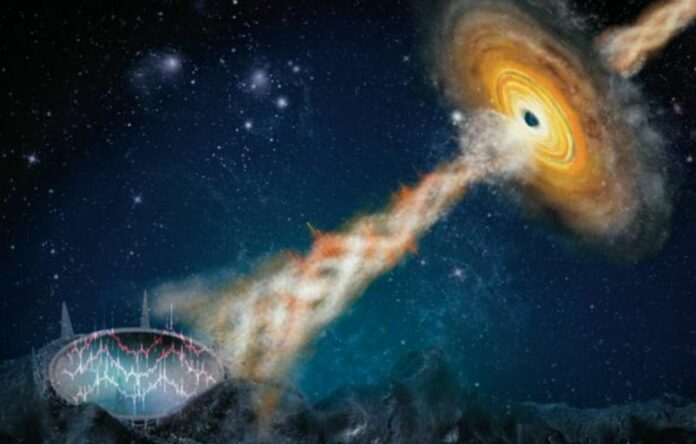Astronomers Unveil Enigmatic Galactic Black Hole Secrets in Nature’s Latest Report
Witness the celestial dance of black holes as an international team of scientists reports the mesmerizing discovery of quasi-periodic oscillation (QPO) signals in the radio band.
In a groundbreaking revelation, an international team of scientists has made history by detecting a quasi-periodic oscillation (QPO) signal in the radio band emanating from a Galactic black hole system. These celestial enigmas, known for their mind-boggling characteristics akin to science fiction tales, have captivated researchers for centuries.
Among these cosmic wonders are stellar-mass black holes, with masses approximately equal to 10 suns, which expose their presence through the consumption of materials from neighboring companion stars. Furthermore, supermassive black holes congregate at the heart of certain galaxies, giving rise to luminous compact regions known as quasars, their masses ranging from millions to billions of solar masses. Additionally, accreting stellar-mass black holes capable of launching jets of magnetized plasma are classified as microquasars.
In an exciting scientific endeavor featured in the July 26 issue of Nature, an international team, including the esteemed UNLV astrophysicist, Bing Zhang, embarked on an extensive observational campaign centered on the enigmatic Galactic microquasar named GRS 1915+105. Their meticulous study brought to light previously unseen aspects of this intriguing microquasar system.
The team employed the Five-hundred-meter Aperture Spherical radio Telescope (FAST) in China, an awe-inspiring instrument, to observe a QPO signal in the radio band, marking a historic first for any microquasar system. QPOs serve as essential tools for understanding the inner workings of stellar systems, particularly black holes. Although scientists have previously detected QPOs in X-rays from microquasars, the unprecedented discovery of these signals as part of the system’s radio emission sets it apart.
Lead researcher, Professor Wei Wang from Wuhan University, China, emphasized the peculiarity of the QPO signal, manifesting with a rough period of 0.2 seconds and a frequency of approximately 5 Hertz. Under specific physical conditions, this signal emerges, although it is not a constant feature. Remarkably, the team had the fortunate opportunity to detect the signal on two occasions, in January 2021 and June 2022.
Bing Zhang, a prominent figure in the study and director of the Nevada Center for Astrophysics at UNLV, speculated that this unique QPO signal might offer the first-ever evidence of activity from a “jet” launched by a Galactic stellar-mass black hole. Jets comprise parallel beams of charged matter and magnetic fields moving at near-light speeds, and certain black hole binary systems exhibit such awe-inspiring phenomena.
Zhang posited a potential explanation for the temporal modulation in a relativistic jet, suggesting that it could be attributed to the jet’s underlying precession. This implies that the jet’s direction periodically shifts, ultimately returning to its original orientation approximately every 0.2 seconds. Such an effect may arise due to a misalignment between the black hole’s spin axis and its accretion disk, which consists of scorching, luminous gases enveloping the black hole. This phenomenon arises naturally from the dragging of spacetime near a rapidly spinning black hole.
Although Zhang’s proposition holds promise, he acknowledged that other possibilities exist, underscoring the importance of ongoing observations of this Galactic microquasar and others. These continued investigations promise to unravel the enigmatic nature of these mysterious QPO signals, unveiling more clues about black hole behavior and the mechanisms behind relativistic jets.
In conclusion, the latest findings from the international team of scientists, with the esteemed contributions of Bing Zhang, serve as a testament to the remarkable progress made in understanding the profound complexities of Galactic black holes. As researchers continue to probe the cosmos, the mysteries surrounding these celestial wonders are gradually unfolding, bringing humanity closer to unlocking the secrets of our universe.
Image Credit: Professor Wei Wang, Wuhan University
